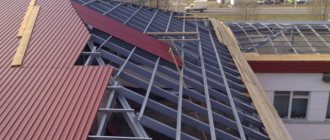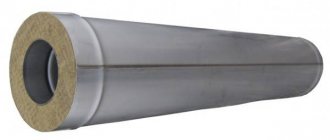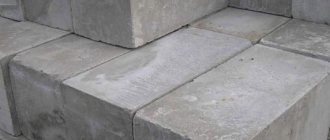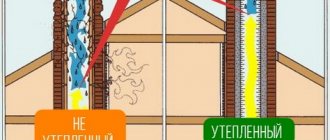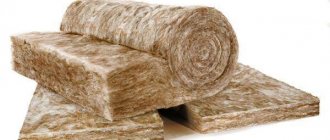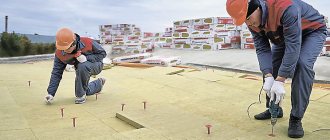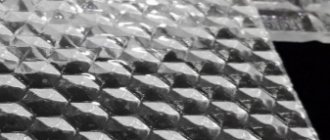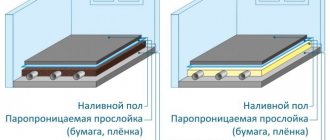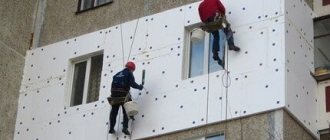We will dry all types of insulation: mineral wool, glass wool, stone wool, penoplex, etc. in the shortest possible time!
Most insulation materials used for roof insulation have a porous or fibrous structure (be it mineral wool, glass wool, etc.). This means that inside the material there are a large number of voids that are filled with air. Actually, this circumstance ensures the low thermal conductivity of insulation. However, this also causes high absorbency of materials.
When insulation gets wet, the voids fill with water, causing its ability to retain heat to decrease dramatically. In winter, moisture freezes, causing frozen areas to form on the ceiling. The result is greater heat loss, wet spots and the risk of mold growth.
Why does insulation get wet?
There may be several reasons why the insulation on the roof was wet:
- Insulation was initially carried out using raw materials. This could happen due to the poor quality of building materials, negligence of workers, or unwillingness to spend extra time on drying. People often believe that thermal insulation will “dry on its own,” but this opinion is wrong. If you have damp insulation installed, dry it as quickly as possible.
- The insulation got wet during installation. If work on the roof was carried out during rain or snowfall, the materials were likely to suffer from moisture. Remember that their texture is wavy, which means they absorb water very quickly. It is best to install thermal insulation in dry weather, but if you still cannot follow this recommendation, call a dehumidifier. It’s better to spend a few days drying than then spend months removing mold and mildew, repairing and completely replacing materials.
- Poor quality or incorrect roof waterproofing. In this case, the waterproofing layer cannot fully perform its functions, which is why moisture seeps under it and is absorbed into the insulation. In the end, this leads to the same problems: wet spots on the ceiling, heat loss, mold.
Consultation with a specialist
By phone Call
Ventilation without errors
One of the more common causes of damp mineral wool is problems associated with roof ventilation. Good ventilation allows air to circulate over the insulation, which allows condensation to systematically evaporate from it
This is why careful design of roof ventilation is so important.
Arkady Shchelyunin, Astrakhan. Question: Good afternoon, it’s raining, autumn. We didn’t have time to make cotton wool on the façade of the expanded clay concrete house. What should we do now? It rains every day. We are afraid that the cotton wool will get wet. Then winter. How to dry it?
Sergey Zaitsev, Moscow, specialist.
Answer: Good afternoon, Arkady. In answer to your question, I can advise you the following. First of all, you are right. If it falls under heavy and prolonged rain, it will absorb moisture. Despite all the advertising assurances of the manufacturers, in the photo with beautiful drops of water on the cotton wool, however, basalt insulation absorbs moisture very well.
Therefore, you can’t get it wet in heavy rain. If during the installation process the cotton wool on the walls gets wet by rain, it’s not a big deal. But if you leave it in the rain for a day, then you won’t be able to really dry it before installation.
So, we do 3 things.
What are the dangers of wet insulation?
Getting the insulation on the roof wet leads to quite unpleasant consequences. As a rule, at first the residents of the house do not notice that anything is wrong. However, they are beginning to feel that the living rooms have become cooler. Moreover, the problem is not solved, even if the heat supply is increased. The more the insulation gets wet, the more noticeable the heat loss. Later, wet spots appear on the ceiling if the ceiling is not suspended. Under tension it is more difficult to notice the problem, but you can recognize it by the smell of dampness. In addition, damp plaster may fall off the ceiling.
An increase in the percentage of humidity in the house inevitably leads to the formation of mold. It not only spoils decorative coatings, but is quite dangerous for people and pets. Mold spores easily travel through the air, enter the respiratory tract, and enter food and water. In the body, they begin to actively multiply, causing severe bronchopulmonary diseases, damage to internal organs, and the central nervous system.
Due to wet thermal insulation, the timber and metal elements that make up the roof are exposed to moisture. Rot literally eats away at the wood, putting the structure at risk of collapse. The metal begins to rust. Corrosion contributes to the deterioration of the characteristics of metal elements, including the weakening of their load-bearing capacity.
Additional services
How to dry a frame house?
Like any other structure, frame houses are exposed to high humidity...

How to dry insulation?
Wet thermal insulation, unfortunately, is not uncommon...

Drying attics and roofs
Attics and roofs are some of the most vulnerable places to moisture...

Drying walls after flooding
Flooding for many is a nightmare that no one would like to experience...
Protection of wool during installation
To prevent the basalt insulation from getting wet during installation, it is worth protecting the installation site from rain. For this purpose it is very convenient to use inventory scaffolding. And on these scaffoldings, lay boards along the upper rungs of the top row and stretch the film.
It will turn out cheap and cheerful. Not only the building materials will be dry, but also the installers themselves who work on the walls.
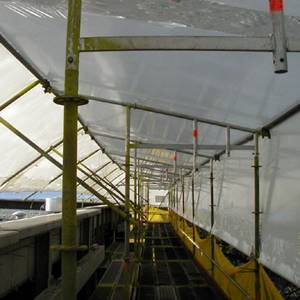
To drain rainwater from film roofs on scaffolds, the easiest way is to use 3-4 drainage pipes with a diameter of 110 mm, into which the water accumulating on the film will be drained. This will allow you not to get wet under an unexpected “waterfall”, when water that does not have a drain bends the film and rushes down in an “unfortunate” place.
What to do with wet insulation on the roof?
If the insulation gets wet while insulating the roof, do not despair. This does not mean that you will have to completely dismantle the insulation and install new one. Many modern insulation materials are impregnated with special hydrophobic substances, which significantly reduce absorbency. For example, mineral wool is often treated with such compounds, so when wet it “resists” water, which greatly simplifies its drying.
However, even very wet material can be dried. This must be done as soon as possible, before moisture causes mold to appear. It is important to remember that high-quality drying is only possible with the use of professional equipment. Often, in order to save money or out of ignorance, people try to dry thermal insulation using heat guns. But this is simply impossible, especially if the insulation is located under the roofing or facade material. The same goes for ventilation. Even if you create a good draft, it will not draw moisture out of the material.
Preparing walls for insulation
If you think that mineral wool, the characteristics of which are suitable for your home, is a good insulation material, then you must first prepare the walls for finishing. If the walls have plaster, it is necessary to remove it to brick, wood, concrete or stone, depending on what the walls of the house are made of.
If there are level differences on the walls of more than two centimeters, then they need to be eliminated. After cleaning the walls from dust and dirt, you can coat the prepared walls with a primer.
When insulating external walls, you will need two types of mineral wool, which will differ in density. The soft slab is laid against the wall, since such wool can fill all the unevenness of the wall. Place the hard slab on the soft slab, this way you will form a smooth surface of the walls on the outside. The total width of the insulation should not be more than 10 centimeters.
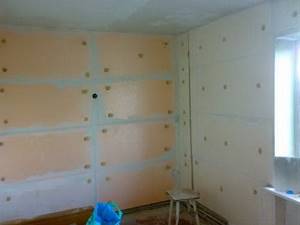
Insulation work begins from the bottom; the slabs are glued using special glue.
When insulating a wall, you will have to adhere to the following sequence: wall, insulation, reinforcing mesh on dowels and facade plaster.
You can also insulate the house by making a ventilated facade. This will help prevent the formation of wet condensation, which harms the mineral wool. Even despite their high moisture resistance, they allow water vapor to pass through their thickness, which can damage both the mineral wool, deforming and delaminating it, and the walls of the house.
How to dry the thermal insulation on the roof without dismantling it?
The most effective and economical way to solve the problem of wet thermal insulation is to have it professionally dried. Special dryers are equipment that extracts moisture from any materials. That is, drainage is not superficial in nature, which ensures its high efficiency. Using drying machines, you can dry the thermal insulation that is located under the roof or facade without dismantling the structure. To date, no other method can give the same result.
The amount of work depends on the area and degree of wetting. The more damp the material, the longer it will take to dry. Drying equipment can be used for any materials: mineral wool, stone wool, glass wool, etc. In this case, you will not have to open the casing. The work is carried out in stages: from the wettest areas to the driest. Moisture is removed outside the drying circuit. As a rule, several installations are used at once, which provides a higher drying speed.
Insulation
All the ecowool intended for my house fit into an elongated GAZelle. The blowing installation was located right on board; a hose was connected to it, the second end of which was directed by the operator to the required places. The operator's assistant, standing on board, opened the packages of ecowool and loaded them into the installation.
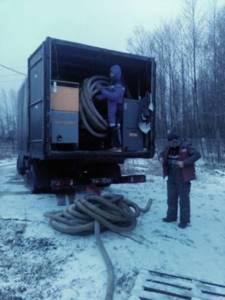
Ecowool and equipment arrived
Ecowool is simply poured into the ceilings and leveled between the joists. There are two technologies for insulating walls - dry blowing and wet spraying. Many people prefer the wet spraying method, which makes it easier to control the density of filling cavities in the wall, but it is more expensive and is not applicable at subzero temperatures. With dry blowing, the quality is highly dependent on the experience of the operator, in addition, more thorough preliminary preparation of the walls is required.
When is a vapor barrier necessary?
It is definitely enough to simply formulate the condition of whether a vapor barrier is needed. When insulating with mineral wool, protection from water vapor will be needed when there is a possibility of contact with air coming from the room.
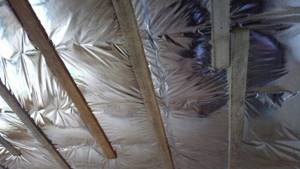
To ensure effective operation, each layer of the thermal insulation “pie” must allow air to pass through to one degree or another. In the direction from room to street, this ability should increase.
Thus, warm air from the room very slowly seeps between the fibers, displacing cold air from there.
There is a small ventilation gap of 1-2 cm under the internal decorative lining. The insulation is installed inside the structure between the supports.
These can be vertical frame posts, floor joists or rafters. A wind-waterproofing barrier is installed on the outside (external) side, protecting from the effects of precipitation and strong direct wind.
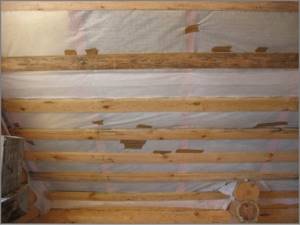
Possible reasons for moisture accumulation in thermal insulation
The problem when the thermal insulation material under the roof gets wet requires an immediate solution. This can happen for many reasons. Here are the main ones:
- During installation, the waterproofing material between the roof and the insulation was damaged. Typically this is a film or superdiffusion membrane. Perhaps the workers broke through it when installing the roof. This often happens when the waterproofing is attached by over-tensioning, which is a mistake. Installation must be carried out so that the waterproofing sag slightly and does not create excessive stress on the material. Also, moisture from possible condensation can collect and drain in places where the film sags.
- The joints of the waterproofing sheet were not carefully taped. In this case, condensation moisture can penetrate through the cracks in the joints.
- Poor installation of waterproofing in places where the chimney or ventilation shafts pass. Here it is necessary to bend the edges of the waterproofing upward and fix it to the pipe walls with a clamping strip or clamp.
- Low-quality material was used for waterproofing; a cheap super-diffusion membrane allows moisture to pass through.
In addition to possible reasons with waterproofing, moisture can penetrate into the insulation due to improper installation of the vapor barrier layer, which should protect the insulation from vapors from the interior. Even with good ventilation, steam is always present and accumulates with warm air at the top of the roof. Therefore, a vapor barrier is always installed before the insulation layer. If it is installed incorrectly or damaged, moisture will penetrate into the insulation.
What to do if the insulation is already wet?
First, you need to determine the degree of wetness of the thermal insulation, regardless of whether the insulation in the floor or roof is damaged. If it is soaked through with moisture, then the only thing left is to throw it away, since it will not be possible to dry the insulation in the roof. However, many modern thermal insulation materials are made with protection against getting wet; for example, mineral wool fibers are impregnated with special hydrophobic substances that prevent the fibers from being saturated with water. And if the insulation is not very wet, then you can try to dry it. How to do it? It is necessary to create a draft so that the moisture gradually evaporates from the insulation layer. To do this, you can use a heat gun. If the weather permits, it is better to remove the roofing or facade covering material and dry the thermal insulation.
If the insulation gets wet, then most likely the weather is not ideal, and drying the insulation may be a problem. After all, the speed of its drying under the roofing or facade material will in any case be low, even if you manage to create a good draft.
The best solution would be to remove the wet thermal insulation and install a new one instead, without making installation errors again. After all, a heat-insulating material that is not completely dried clearly has a worse coefficient of heat transfer resistance, which entails increased heat loss and heating costs. In addition, high humidity has a bad effect on wooden supporting structures, which threatens the need for their rapid repair. And these are costs of a different order than simply replacing the insulation, and the savings may come back to bite.
What harm does condensation cause?
Condensation on the roof seriously damages various insulation materials, such as mineral wool. Due to moisture, it not only turns into lumps, but also loses its properties. Wet cotton wool will not last longer than two years, although in dry conditions it will not need to be replaced even after 20 years.
Roof repairs are quite expensive. Due to moisture, supporting structures may suffer, for example, joists and the roof will sag, begin to leak, or collapse. That is why it is necessary to deal with condensation immediately after its detection, without postponing the solution to the problem until later.
JSC "Sinus" - effective drying of any premises and materials
Our company’s specialists are engaged in the dehumidification of houses, apartments, office premises, factories, basements, as well as building materials. For our work, we use certified high-end equipment made in America and Europe. The machines are safe and do not emit heat or dust during operation. If the insulation gets wet while insulating the roof, call a dehumidification team.
Our company employs 20 mobile teams. We go to the site 30 minutes after you leave your request. The company operates 24 hours a day, 7 days a week. We help fight the consequences of flooding, flooding, eliminate mold, mildew, and dry houses and apartments during repairs and construction. We have tens of thousands of successfully dried objects, so we guarantee 100% results.
Thermal insulation of an attic roof means three benefits in one solution. Firstly, the house becomes noticeably warmer. Secondly, heating costs are reduced by 30-50%. Well, and thirdly: a residential floor appears. They finished the walls and got cozy rooms under a roof instead of a cluttered attic.
A popular roofing insulation is mineral wool. A material with excellent performance characteristics, non-flammable and affordable.
